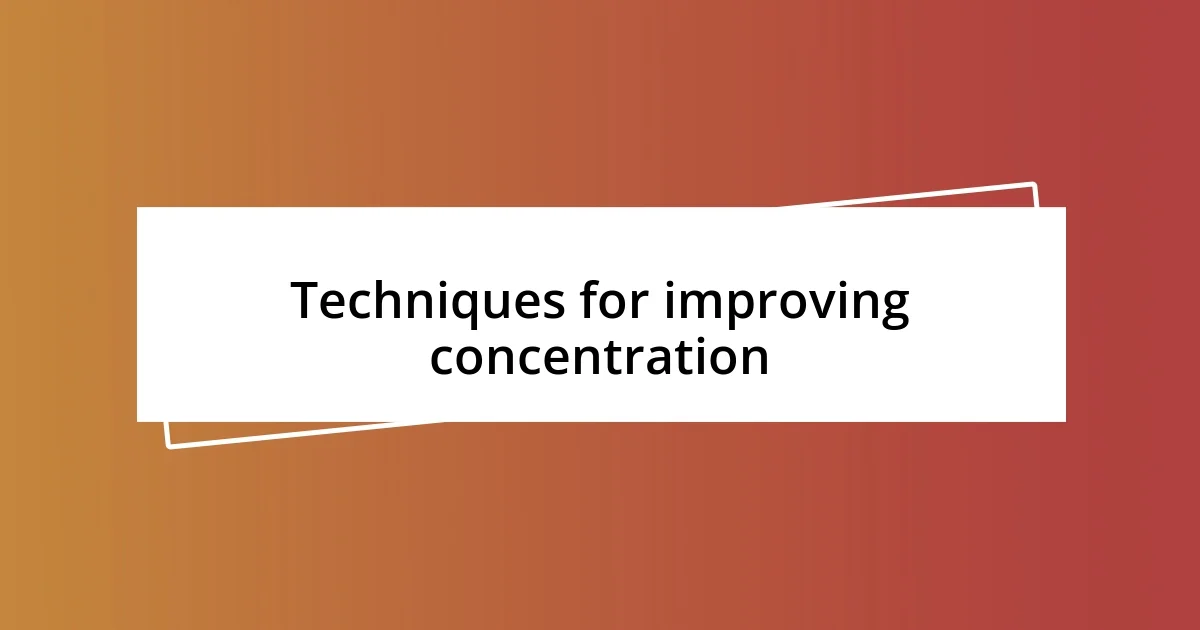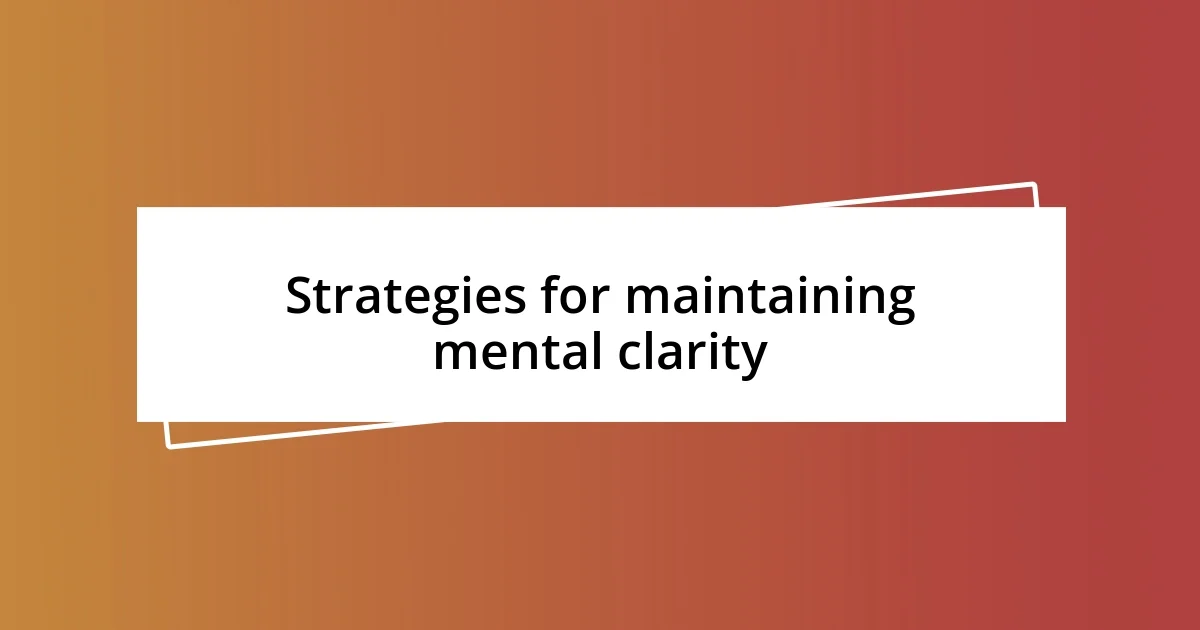Key takeaways:
- Focus in sports is crucial for performance; it can be developed through techniques like mindfulness and visualization.
- Identifying distractions, such as external noise and self-doubt, is essential for maintaining concentration during competitions.
- Monitoring progress and adjusting techniques based on performance patterns improves overall focus and skill enhancement.

Understanding the importance of focus
Focus in sports isn’t just about keeping your eyes on the ball; it’s about centering your mind amidst distractions. I remember a time during an important game when my thoughts began to stray. My mind was wandering to what I had for lunch, and just like that, I missed a crucial play. It made me realize that even the smallest distractions can derail my performance.
When I’m in the zone, everything feels sharper. The cheers from the crowd fade away, and it’s just me and the game. Have you ever experienced that sense of clarity? It’s like being in a bubble where every movement feels deliberate. For me, that focus is essential; it allows me to execute strategies and anticipate my opponent’s next move with precision.
I’ve often found that maintaining focus is a skill that can be developed, much like physical training. I once struggled significantly during longer matches, but by practicing mindfulness and concentration techniques, I saw noticeable improvements. How often do we let our minds wander to thoughts that don’t serve us? Embracing tools like visualization and controlled breathing transformed not just my concentration but my entire approach to sports.

Identifying distractions in sports
Identifying distractions in sports is a pivotal step in honing your focus. I’ve often noticed that distractions can come in various forms, ranging from external noises to internal thoughts. In one memorable game, I found myself distracted by the buzzing of my phone in my gym bag, reminding me of pending messages. Ignoring that distraction proved nearly impossible, and it impacted my performance. It’s crucial to recognize these distractions early on to mitigate their effects.
Here’s a quick list of common distractions athletes might face:
– External Noise: Crowd cheers, commentators, or even nearby conversations
– Social Media Notifications: Temptations to check messages or updates during downtime
– Self-Doubt: Lingering thoughts about past mistakes or fears of failure
– Physical Discomfort: Pain or fatigue can divert attention from the game
– Environmental Factors: Weather conditions or unexpected changes in the playing surface
Being aware of these distractions helps in creating strategies to stay focused. It’s about anticipating what can pull you away from the moment and proactively addressing it.

Techniques for improving concentration
When it comes to improving concentration, I’ve found that the power of visualization is truly transformative. Before a big game, I close my eyes and mentally rehearse each play, imagining myself executing every move with precision. This technique not only enhances my confidence but also creates a mental map of success, making it much easier to focus when the game begins. Have you tried picturing your performance in this way? It can turn anxiety into excitement.
In addition to visualization, I utilize controlled breathing as a technique to clear my mind. Before stepping onto the field, I take deep breaths, allowing myself to settle into the moment. During a particularly tense match, this practice helped me center myself when distractions were overwhelming. I felt my heart rate slow down and my thoughts crystallize, enabling me to refocus on what truly matters—playing my best.
Another method I find effective is setting specific goals, even for practice sessions. By focusing on small, achievable targets, I break my concentration efforts into manageable pieces. I remember a training day when I aimed to improve my free throw accuracy. By zeroing in on that single objective, I blocked out noise and distractions, ultimately leading to a significant improvement in my skills. I encourage you to try this. What small goal will you set for your next practice?
| Technique | Description |
|---|---|
| Visualization | Mental rehearsal of successful performance to build confidence and clarity. |
| Controlled Breathing | Deep breaths to calm nerves and refocus attention on the task at hand. |
| Specific Goal Setting | Setting small, clear objectives for practice to enhance focus in training. |

Strategies for maintaining mental clarity
One strategy I value for maintaining mental clarity is the use of a pre-performance routine. I’ve developed a sequence of physical and mental exercises that signal to my brain that it’s time to switch into focus mode. For instance, before every match, I take a moment to stretch while visualizing my best plays. This simple routine not only calms my nerves but also helps anchor my thoughts, making it easier to stay present. Have you ever noticed how a consistent ritual can help settle your mind?
Another approach I rely on is digital detoxification during training sessions. It’s tempting to check notifications or scroll through social media, but I’ve realized that these interruptions create mental clutter. For me, putting my phone on airplane mode during practice has been a game-changer. I feel liberated from the constant pinging, allowing me to dive fully into my training without distraction. If you haven’t tried this yet, I highly recommend it; you might be surprised by how much more you can accomplish focus-wise!
Lastly, I find that journaling my thoughts after sessions provides a clear pathway to mental clarity. After a tough practice, I jot down what went well, what didn’t, and any lingering thoughts. This practice not only helps me to process my experiences but also reinforces my learning for the next time. I can look back on my entries and see patterns in my thoughts and feelings that I might want to work on—like how stress can creep in and affect my performance. Have you ever tried capturing your thoughts this way? It can be incredibly enlightening!

Utilizing visualization in training
Utilizing visualization has become an essential part of my training routine. I vividly recall a workout where I faced an intense mental block. I closed my eyes and pictured myself dominating the course—every stride, every jump, perfectly executed. The moment I visualized myself crossing the finish line, my mind cleared, and I found my rhythm. Have you ever experienced that shift when you visualize success? It’s a powerful way to transform fear into fuel.
I often pair visualization with my training drills. For instance, when I practice my shooting technique in basketball, I not only focus on my physical form but also imagine the ball swishing perfectly through the hoop. This dual approach not only solidifies the mechanics in my mind but also reinforces the emotional exhilaration of success. There’s something about feeling that joy before it even happens that energizes me—don’t you think that anticipation can enhance performance?
What’s fascinating is how visualization can even adapt to my challenges. Before a competition where I might feel overwhelmed, I create a mental scenario where I encounter obstacles, like a tough opponent or high-pressure moments. I visualize myself responding calmly and strategically, transforming what could be anxiety into a rehearsal of resilience. It’s incredible to realize that our minds can practice just as effectively as our bodies can, right? It makes training feel multi-dimensional and far more engaging.

Monitoring progress and adjusting techniques
Monitoring progress is a crucial aspect of improving focus in sports. I remember my first season of competitive swimming, where tracking my lap times became a ritual. Each week, I compared my times to previous ones, celebrating small victories and identifying areas for growth. It was through this analysis that I discovered patterns: certain days were ripe for peak performance, while others were not. Have you ever taken the time to reflect on your performance and noticed similar patterns?
Adjusting techniques based on progress can be transformative. After a discouraging match in tennis, I realized my serving needed more attention. I sought feedback from a coach and incorporated specific drills into my practice regimen. The results were noticeable; I started serving with confidence, and my overall game flourished. It’s fascinating how a simple tweak can elevate your performance. Have you considered which aspects of your technique could use a little fine-tuning?
Lastly, I’ve found that adaptability is key in maintaining focus. I often reassess my strategies after periods of stagnation or frustration. For instance, when I felt my concentration waning during long-distance runs, I experimented with integrating music into my sessions. While it may seem counterintuitive for some, it turned out to be a game-changer for me. This flexibility in adjusting my approach keeps my training fresh and invigorating. What adjustments have you made when you hit a plateau? I believe that embracing change can lead to remarkable breakthroughs.














